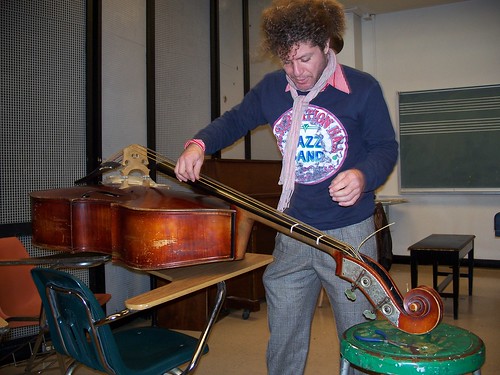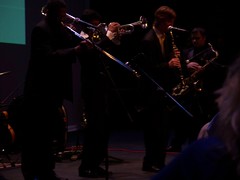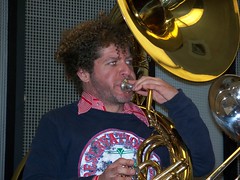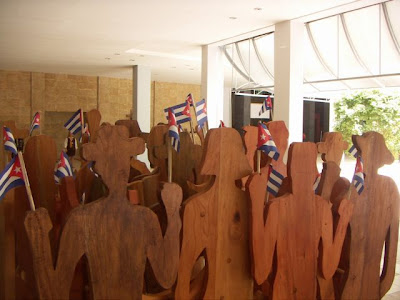 The USF Jazz Blog got a much appreciated nod from be.jazz, a Belgian jazz blog. Check out this visually appealing, insightful blog.
The USF Jazz Blog got a much appreciated nod from be.jazz, a Belgian jazz blog. Check out this visually appealing, insightful blog.
|
||||||
|
Facts and Opinions: 1|A very young Miguel Harth-Bedoya led the orchestra in all three works without a score! This left him plenty of room on the podium to move around and practically get right there with the top desk strings. The program: Tchaikovsky’s Romeo and Juliet Overture, De Falla’s The Three-Cornered Hat, and Rimsky-Korsakov’s Scheherezade.
It’s hard to believe I was studying with a member of the Cleveland Orchestra (much less one sitting at the top desk) within a year of beginning my double bass studies. I have Mike Hill to thank for the contact and Kevin to thank for his patience. Should I ever move back to Cleveland, the first call I make (after family, before the cable guy) is to Kevin to set up lessons. I hear in those minidiscs his patience and my naivete and it’s almost embarassing. Some days I feel like I haven’t improved much since I left Kevin. I know it’s not true, but I also know I’m not playing at a level near where I should be. It’s my own fault and something I can rectify. I went to see someone I consider a friend play in one of the best Orchestras in the world and was reminded why I love the double bass.
Unfortunately, this is not something I practiced (pun intended) during my undergrad years. Now is a different story, though. This was the first weekday morning of my 2007 Spring Break and I spent it warming up, relishing the practice time. I even got to spend time in the front yard, warming up and waving at the neighbors! I now look at breaks as an opportunity to put away all the distractions of classes and ensembles and focus on my instrument, cleaning up technique and intonation, learning new tunes and more ways to play a scale. What are you doing with your Spring Break?
Westchase is one of those upscale suburban developments that thinks it is a posh European town, with a marketplace area and cafes.
Rich, a candidate for MM in Jazz Comp at USF, works at this particular store and has worked to get weekly live jazz in four West Tampa/Pinellas County Starbucks locations! I really appreciate Rich’s efforts to make live jazz happen wherever it can and am in awe of management who is willing to see the value of having such music, even if the numbers don’t always come out favorably. Everytime I’ve played a Starbucks gig with these guys, the turnout has been great and the response extremely positive. I have been in contact with management at several Polk County Starbucks about creating weekly live jazz in Lakeland and am excited to see what may come out of this. If you’re a jazz musician looking for a gig, consider contacting your local Starbucks manager about setting up a weekly. Just make sure you promote like there’s no tomorrow! How Low Can You Go? Anthology of the String Bass (1925-1941)
I can’t even say that I’ve been through the entire anthology yet. I haven’t gotten to the third disc and am only half-way through the book, but I am already thrilled with this purchase. The photos in the book are worth the price alone! I have been stuck on the second disc, Wilmoth Houdini’s Tiger Tom Kill Tiger Cat, Damblay, Santapie and Rat, The Spirits of Rhythm’s Dr. Watson and Mr. Holmes, and the classic Yes Sir, That’s My Baby by Roy Acuff and His Crazy Tennesseeans in particular.
Local Restaurants offered free food from 12:00-1:00 while the Herd of Thunder Marching Band and members of the USF Jazz department played. Students from Theater, Visual Arts, and Dance provided entertainment as well. Wish you were there… The Jazz Bass Book
John Goldsby’s “The Jazz Bass Book|Technique and Tradition” goes a long way toward filling in the gaps that exist in most bassists’ vision of the past. After a forward by legendary Ron Carter and an inspiring preface entitled Bass is Beautiful, Goldsby breaks the book into four sections:
the Players Technique Concepts “the History” is an abridged discourse on the development of the bassist’s role in jazz, devoting one chapter to advancements in walking technique and devotes chapters to bebop and an account of five classic rhythm sections. “the Players” is the meat of this book, ranging from early New Orleans bassists (Pops Foster, Bill Johnson, et al), Slam Stewart and Milt Hinton to Ron Carter, Dave Holland and Rufus Reid. Some bassists receive more spotlight than others and there are notable modern exclusions (Avishai Cohen, John Patitucci, John Clayton…), but I can imagine Goldsby toiled effortlessly to provide the best balance between coverage and space. What I find most valuable about this section is that every bassist listed is accompanied by discographical information, allowing budding bassists guidance while building their listening libraries! The “Technique” section discusses practicing methods, intonation, chord/scale issues, the Trane matrix, as well as some etudes. Closely related is the “Concepts” chapter, which discusses versatility, creativity, swing, and integrity. Integrity is an issue I have been dealing with recently, trying to ensure that I put in the effort expected of me in order to honor the commitments I’ve made to myself, teachers, bandmates, etc. I have found this book invaluable in determining where I fit in the musical spectrum and has been an amazing resource in guiding my CD purchases. If you are a student or teacher looking for an in-depth view of the Double Bass’ development and role in Jazz, get this book now!
Being a bass player, I was excited to have a bass player come to do MNJ and give a masterclass after the semester of trumpets. I wasn’t, however, entirely sold on the idea of a MNJ devoted to New Orleans Jazz. I am not into trad jazz of any sort and, though I understand its importance in developing my jazz world view and that the music I tend to play wouldn’t exist without it, I just don’t really enjoy listening to it; it’s not my typical choice for “cruise” music.
During this time and throughout the concert, videos of early jazz were being projected behind the band. After the combo went on, Ben provided commentary on some of the videos he had brought from his personal collection. These were extraordinary videos about Preservation Hall and Jazz Funerals. The main event featured the faculty jazz combo with the exception of drummer Steve Davis, whose spot was covered by USF alumnus Ian Goodman. They covered Do You Know What it Means to Miss New Orleans?” and other classic New Orleans tunes. The highlight for me was Jaffe and Wilkin’s statement on Gershwin’s I Got Rhythm, a recreation of the famous Don Byas|Slam Stewart Town Hall recording. I found this MNJ concert and Ben Jaffe to be extremely inspiring and have decided to devote a portion of my study/practice to understanding more traditional forms of bass playing. To that end, I will be using the school Juzek (strung with all guts) and have ordered How Low Can You Go?, a three-disc collection chronicling the double bass in early music.
It addresses the lack of audition screens at Cleveland Orchestra auditions and the influence of concertmaster William Preucil on the orchestra. I won’t comment, because I have no firsthand knowledge of any of the issues at hand, but those currently on the audition circuit may find this enlightening (or at least in agreement with what they have heard through the grapevine). |
||||||
|
Copyright © 2025 Matthew Wengerd's Weblog - All Rights Reserved |
||||||

 If you haven’t done so already, please
If you haven’t done so already, please 
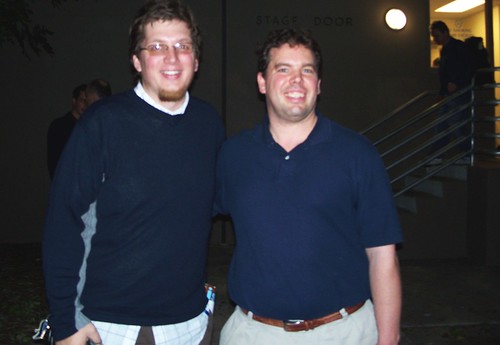
 As an undergrad, I talked a lot about the fact that music students do not get the kinds of breaks that math, education, business, etc. majors get. We have to practice through Spring Break and Christmas Break and all Summer; meanwhile, the others are at Panama City Beach or skiing in Vale. Yes, I know many of them do internships or work career-related Holiday jobs. As Musicians, however, it is a necessity that we not take time away from our major. An occasional weekend or two is often just what the Dr. prescribed, but it is completely unacceptable for a music student to need to get re-acquainted with their instrument the first week of classes.
As an undergrad, I talked a lot about the fact that music students do not get the kinds of breaks that math, education, business, etc. majors get. We have to practice through Spring Break and Christmas Break and all Summer; meanwhile, the others are at Panama City Beach or skiing in Vale. Yes, I know many of them do internships or work career-related Holiday jobs. As Musicians, however, it is a necessity that we not take time away from our major. An occasional weekend or two is often just what the Dr. prescribed, but it is completely unacceptable for a music student to need to get re-acquainted with their instrument the first week of classes.

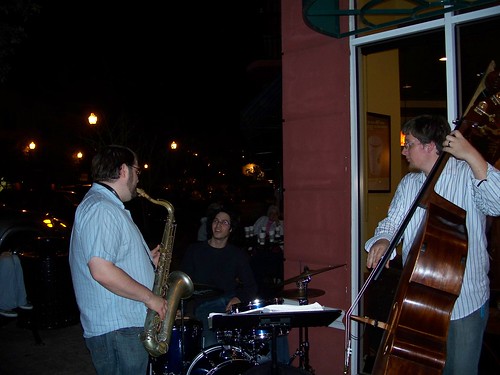
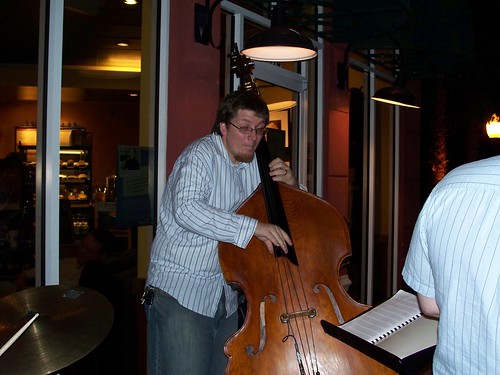
 Most people around me know that, after the Ben Jaffe MNJ and Masterclass, I’ve developed a bit of an affinity for trad jazz and early American Music.
Most people around me know that, after the Ben Jaffe MNJ and Masterclass, I’ve developed a bit of an affinity for trad jazz and early American Music. 


 I have been telling my students for several semesters now that listening is possibly the most important activity in which a musician can engage. As bass players, it is important that we understand our heritage and recognize the names, sounds, and styles of our musical fathers.
I have been telling my students for several semesters now that listening is possibly the most important activity in which a musician can engage. As bass players, it is important that we understand our heritage and recognize the names, sounds, and styles of our musical fathers. 

